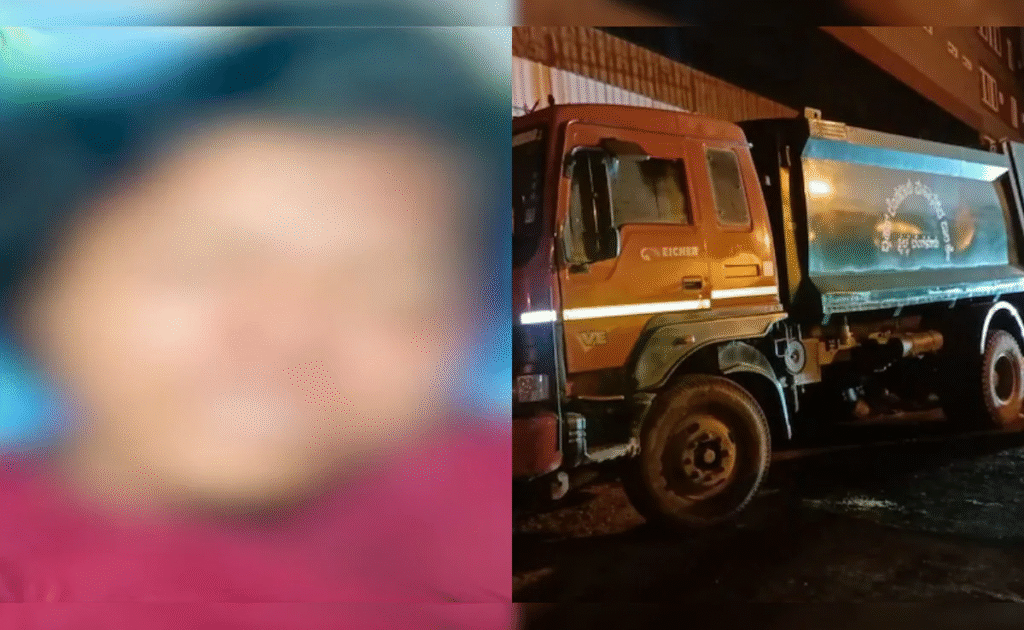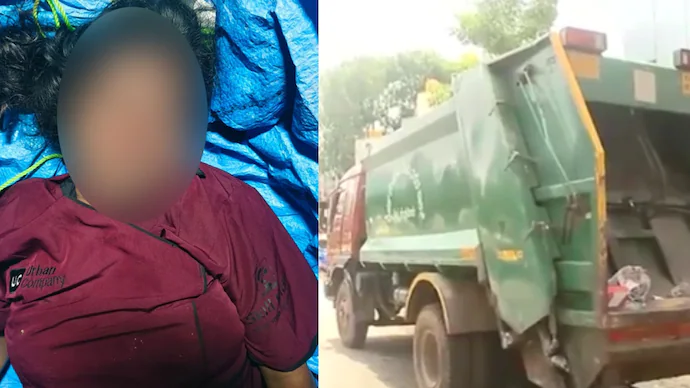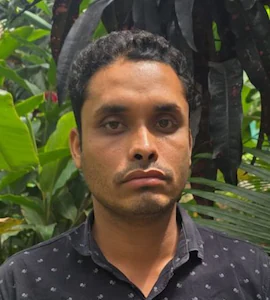Bengaluru Woman Found Dead in Garbage Truck: 5 Key Facts About Live-In Partner Case
The Bengaluru Garbage Truck Murder – A Case That Shook the City
On a quiet Sunday morning in Bengaluru, what should have been a routine waste collection turned into the beginning of a horrific murder investigation. A woman’s lifeless body, stuffed inside a gunny sack, was discovered inside a garbage truck operated by the Bruhat Bengaluru Mahanagara Palike (BBMP). What followed was a chilling unraveling of events that exposed domestic abuse, deception, and a murder carried out with disturbing calculation.
Discovery of the Body
On the morning of June 30, BBMP sanitation workers made a gruesome discovery while loading trash in South Bengaluru. Inside a tightly sealed sack, they found the body of a woman. Her hands were bound, suggesting foul play. The police were immediately called to the scene.
A murder case was registered, and the Bengaluru Police South Division initiated a full-scale investigation. The body was sent to a nearby government hospital for postmortem.
Victim Identified: Asha, 40 Years Old
Within hours, police confirmed the victim’s identity as Asha, a 40-year-old resident of Bengaluru. Asha worked as a housekeeping service provider through Urban Company, a popular home services platform.
Initial findings established that she was a widow and mother of two children, living in a rented apartment in the Hulimavu locality. However, she had been missing for over 24 hours before her body was found.
Tracing the Suspect
Bengaluru Police meticulously combed through CCTV footage from the Hulimavu area and garbage truck routes. One particular frame stood out: a man transporting what appeared to be a large, heavy sack on a two-wheeler. Through tracking and digital surveillance, the man was identified as Mohammed Shamshuddin, a 33-year-old originally from Assam.
Profile of the Accused: Mohammed Shamshuddin
The accused was found to be Asha’s live-in partner for over 18 months. Though both were legally married to different spouses and had children from those marriages, they had been living together in South Bengaluru under the pretense of being husband and wife.
- Mohammed Shamshuddin’s wife and children reside in Assam
- Asha’s two children live with relatives
- Neighbors were under the impression that the couple was legally married
The Relationship: A Volatile Mix of Love and Lies
Investigations and testimonies from neighbors revealed that the couple frequently fought. Police believe that on the night of the incident, an argument between the two escalated into a physical altercation, ultimately resulting in Asha’s death.
The Crime: A Calculated Act
According to Deputy Commissioner of Police (South) Lokesh B Jagalasar, Shamshuddin strangled Asha during the argument. After confirming her death, he:
- Wrapped her body in a gunny sack
- Tied her hands to prevent exposure or identification
- Transported the body on a two-wheeler under the cover of night
- Dumped the sack into a BBMP garbage truck, hoping it would go unnoticed
The entire act was captured by neighborhood CCTV cameras, providing clear evidence of the sequence of events.
Forensic and Legal Procedures Initiated
The autopsy confirmed death by strangulation. Toxicology reports were ordered to determine if she was drugged or unconscious prior to the act. Meanwhile, forensic teams recovered fibers and hair from the sack, establishing a material link to the couple’s shared residence.
Shamshuddin was arrested on July 1 in an operation conducted by Hulimavu Police. He was produced before a magistrate and is currently in police custody pending further interrogation.
Legal Ramifications, Forensic Breakthroughs, and Urban Vulnerabilities
As details surrounding the murder of Asha in Bengaluru began to emerge, so did wider questions about India’s domestic abuse laws, the efficacy of live-in relationship protections, and the role of forensic science in building criminal cases. This section delves into the legal frameworks, procedural insights, and deeper urban societal issues underpinning the case.
Charges Framed Against Shamshuddin
After a preliminary interrogation and forensic correlation, Bengaluru Police charged Mohammed Shamshuddin with the following:
- IPC Section 302 – Murder
- IPC Section 201 – Causing disappearance of evidence
- IPC Section 376 (if rape evidence emerges) – Ongoing forensic scrutiny
- Section 498A (in applicable context) – For domestic violence allegations
Legal experts assert that if proven guilty, Shamshuddin could face life imprisonment or capital punishment under Section 302.
Role of Digital and Forensic Evidence
The police’s investigation was significantly aided by:
- CCTV Analysis: Tracked movement from residence to disposal site
- Mobile Tower Dump Analysis: Pinpointed Shamshuddin’s location at critical moments
- Text Message Forensics: Retrieved messages indicating prior arguments
- Fingerprint and DNA Sampling: Collected from residence and sack
- Material Link: Matching rope fibers and detergent from the apartment
Statements and Confession
Under sustained questioning, Shamshuddin admitted to the crime but claimed he acted in a “fit of rage” after repeated arguments. He insisted he had no intent to kill and panicked post-incident.
His statement is yet to be verified against evidence, and police are awaiting final forensic results to determine whether premeditation can be established.

Legal Grey Zone: Live-In Relationships in India
The couple’s live-in status presents unique legal complications. While the Protection of Women from Domestic Violence Act, 2005 extends certain rights to women in live-in relationships, enforcement remains inconsistent.
Advocate Meenakshi Rao, a family law specialist, observed:
“This case highlights the urgent need for real-time legal outreach to women in non-marital cohabitations. The current legal apparatus does not provide adequate preventive support.”
Systemic Concerns: Safety Net for Urban Women
Many urban working women, like Asha, live independently or in informal relationships. The system’s failure to protect them stems from several gaps:
- No mandatory registration or database of live-in partnerships
- Minimal social checks in low-income or rented housing clusters
- Limited access to women’s shelters or crisis intervention hotlines
According to data from the National Crime Records Bureau (NCRB), 15% of all murders of women in urban areas stem from domestic or intimate partner violence.
Public Response and Women’s Groups
The murder sparked strong reactions across Bengaluru:
- Candlelight vigils were held in memory of Asha
- Women’s rights groups demanded better sensitization of police in urban abuse cases
- Social media campaigns like #JusticeForAsha gained traction
The All India Progressive Women’s Association (AIPWA) released a statement:
“This is not a standalone case. It’s a tragic reminder that urban invisibility protects abusers, and women in live-in relationships need legal guarantees of dignity and safety.”
Community and Policing Challenges
Hulimavu, like many fringe urban localities, has limited community policing structures. Lack of tenant verification, weak local resident welfare committees (RWAs), and high population turnover create conditions for anonymity — ideal for hiding abuse.
BBMP officials are now in consultation with Bengaluru Police to:
- Install more CCTV cameras in garbage routes
- Mandate tenant registration with local police stations
- Launch community watch programs in vulnerable wards
A Pattern of Violence? Further Investigations Underway
Police are investigating whether Shamshuddin has a prior criminal record in Assam or any FIRs lodged against him by previous acquaintances. His digital footprint is also being scanned for connections to:
- Online abuse or harassment complaints
- Unresolved missing persons reports
So far, no previous criminal records have emerged, but Bengaluru Police is working with Assam authorities to verify local background details.
Tech-Driven Policing, Survivor Networks, and National Discourse on Women’s Safety
The Bengaluru garbage truck murder case has not only shaken the city but stirred a broader dialogue around gender-based violence, urban anonymity, and the role of digital tools in modern law enforcement. As the investigation deepens, this part explores how technology, legal advocacy, and public consciousness interact to build systemic safeguards—or expose their absence.
Tech in Policing: The Digital Footprint Trail
Modern criminal investigations are increasingly driven by technology. In this case, the following tools proved pivotal:
- CCTV Mapping: Using integrated feeds across Bengaluru wards, police tracked the sack from the couple’s residence to the BBMP garbage truck.
- GPS Tagging: Municipal vehicles equipped with GPS helped investigators establish the truck’s origin point and travel timeline.
- Mobile Data Analysis: Call detail records (CDRs) and tower pings revealed Shamshuddin’s exact movements on the night of the murder.
- Digital Forensics: Phone messages and deleted chats were recovered using specialized software, painting a psychological portrait of the events leading up to the murder.
The Karnataka State Crime Records Bureau (KSCRB) has announced plans to upgrade forensic labs and expand its Cyber Crime Unit’s scope in the wake of this high-profile case.
Urban Isolation and the Anonymity Crisis
Asha’s murder reflects a broader issue: the vulnerability of women living in urban pockets where community ties are weak. In densely packed but socially fragmented metros like Bengaluru:
- Tenants are rarely registered
- Women often hesitate to report domestic abuse due to fear of eviction or retaliation
- There is a cultural silence around live-in relationships
Dr. Priya Rao, a sociologist at National Institute of Advanced Studies, said:
“Modern cities create islands of isolation. Even within a crowded neighborhood, women can suffer unnoticed unless community-based support structures are actively nurtured.”
Building Survivor Networks and Safe Living Systems
Following this incident, multiple NGOs have started mobilizing efforts to create safety channels:
- Sakhi One-Stop Centres are coordinating with apartment associations to offer legal aid and emergency assistance
- Garima Women’s Network is rolling out community awareness drives focused on recognizing abuse symptoms
- Tech platforms like Safecity are encouraging women to anonymously report unsafe zones in the city
Legal Aid and Live-In Protection Advocacy
Public interest litigators have called for urgent recognition of live-in partnerships under Indian family law statutes. While the Supreme Court has upheld the right to cohabitation, there is no statutory protection equivalent to that of marriage.
A PIL has been filed in Karnataka High Court seeking:
- Mandatory police sensitization on handling complaints from live-in partners
- A legal framework offering live-in women protection against physical, financial, and emotional abuse
Media’s Role and Responsible Coverage
While the incident received blanket coverage, ethical questions arose over how Asha’s identity was revealed without family consent and how certain media houses sensationalized the live-in angle.
The Press Council of India has since issued a reminder to media outlets to:
- Protect the dignity of victims
- Avoid speculative reporting during ongoing investigations
- Ensure live-in relationships are not vilified
National Dialogue and Parliamentary Mention
The murder case was referenced in the Lok Sabha during a debate on women’s safety. Lawmakers from multiple parties stressed:
- The urgency of establishing more women’s helplines with field responders
- Introducing legal provisions for emergency restraining orders in live-in scenarios
- Educating urban populations on rights, consent, and domestic laws
Policy Proposals on the Table
Following discussions among Bengaluru civic bodies, women’s commissions, and legal experts, the following initiatives are under proposal:
- Urban Women’s Safety Code: A draft set of guidelines for housing societies and rental units
- Intimate Partner Violence Registry: A proposal similar to sex offender registries in the US
- Live-In Relationship Legal Toolkit: A government-issued guidebook on rights and legal recourse
As the trial looms and the city reckons with the brutality of the crime, the Bengaluru garbage truck murder is no longer just a local case—it is now a symbol of institutional gaps, societal silence, and the urgent need for an empathetic, responsive legal framework for women outside traditional matrimonial setups.
Judicial Response, Parallel Case Studies, and Long-Term Solutions
The murder of Asha in Bengaluru has reached beyond local law enforcement and into courtrooms, legislative halls, and policy institutions. In this part, we evaluate how the Indian judiciary has handled similar cases in the past, what precedents may influence the prosecution, and which reforms can fortify women’s safety in informal relationships.

Judicial Track: Status of the Case
As of July 2, 2025, Mohammed Shamshuddin remains in police custody, and the First Information Report (FIR) has been filed under Sections 302 and 201 of the Indian Penal Code. The chargesheet is expected within 90 days, as per the Criminal Procedure Code.
The Sessions Court in Bengaluru has taken cognizance of the case. Hearings are expected to begin later this month. The Public Prosecutor assigned to the case has requested fast-track proceedings given the gravity of the crime.
Judicial Precedents: Similar Cases in Review
India has seen several high-profile murders involving live-in partners. These cases often mirror common issues—delayed intervention, inadequate support for women, and complexities in prosecuting domestic partners without marital documentation.
- Shraddha Walkar Case (Delhi, 2022)
- Victim murdered by live-in partner
- Dismemberment and disposal of body parts
- Highlighted lack of police tracking of missing persons
- Ramya Reddy Case (Hyderabad, 2019)
- Strangulation after domestic altercation in cohabitation
- Conviction achieved through electronic evidence
- Vibha Saxena Case (Gurugram, 2020)
- Emotional abuse escalated to physical violence
- Supreme Court issued observation on extending domestic violence protections to live-in partners
These cases demonstrate growing judicial acknowledgment of relationship-based violence outside marriage.
Role of Judiciary in Redefining Domestic Safety
In recent years, the Supreme Court of India has delivered progressive judgments:
- Indra Sarma v. V.K.V. Sarma (2013): Recognized the right to protection from abuse in live-in relationships
- D. Velusamy v. D. Patchaiammal (2010): Defined criteria for a valid live-in partnership under DV Act
In light of these, legal experts believe that Shamshuddin’s defense—citing the absence of marital status—will hold little sway in shielding him from severe sentencing.
Prosecution Strategy
According to legal counsel advising the victim’s family, the case will prioritize:
- Establishing premeditation or pattern of abuse
- Leveraging digital footprints and physical evidence to affirm intent
- Seeking maximum sentence under Section 302 (murder)
Legal Aid and Victim Representation
Asha’s family has received support from the Karnataka State Legal Services Authority, which is assisting in the trial process. Victim protection measures have also been extended to her two minor children.
Comparative Statistics: Women Killed by Partners
A 2023 report from the National Commission for Women (NCW) noted:
- 1 in 5 urban women victims of homicide were killed by intimate partners
- 36% of these cases occurred in live-in or non-marital arrangements
- Conviction rate in such cases stood at just 41%, largely due to evidence tampering or lack of witness cooperation
Law Reform Momentum: Bridging the Legal Gap
In the aftermath of Asha’s case, legal scholars and women’s rights groups are proposing:
- Live-In Relationship Registration Act – Optional but encouraged formal declaration with local authorities
- Urban Safety Registry – Mandated reporting of cohabitation in RWA-managed housing
- Protection of Domestic Cohabitees Bill – Draft legislation offering civil protections like restraining orders, financial support, and emergency relocation
Education and Sensitization as Long-Term Measures
The National Commission for Women and the Ministry of Women and Child Development have initiated pilot programs in Bengaluru, Mumbai, and Delhi aimed at:
- School-level curriculum additions on relationship safety
- Mandatory HR trainings on intimate partner violence in corporate offices
- Digital campaigns educating women about signs of abuse and legal recourse
Mental Health Infrastructure: Critical But Neglected
Psychiatrists and trauma counselors argue that both survivors and perpetrators often lack access to mental health support. For instance:
- Bengaluru has just 1 government-funded trauma center for abuse survivors
- No dedicated therapy hotline exists for individuals in live-in distress
- Psychiatric screening is rarely part of court-mandated counseling
The judicial lens now focused on the Bengaluru garbage truck murder must go beyond punishment. It must catalyze meaningful, enforceable changes in how India defines domestic spaces, relationships, and responsibilities. The case of Asha is not an anomaly—it is the mirror of a silent crisis plaguing many cities.

Global Parallels, Media Literacy, and India’s Gender Justice Horizon
The Bengaluru garbage truck murder case is not merely a singular tragedy—it is a critical inflection point in India’s social, legal, and policy narrative on gender violence. In this concluding part, we will compare international models of justice and protection for women in non-marital partnerships, analyze the role of media and public education, and outline what India can adopt to strengthen gender justice systems.
Global Legal Models: How the World Protects Cohabiting Women
- United States
- Most states treat domestic violence in live-in relationships on par with spousal abuse.
- Restraining orders are swiftly issued.
- Mandatory arrest policies in several states if abuse is reported.
- Canada
- Common-law partnerships receive many of the same protections as legal marriages.
- Victim services provide housing, mental health support, and relocation funding.
- France
- Legal recognition of “concubinage” gives rights to cohabiting partners.
- Tracking bracelets are used on convicted domestic abusers.
- South Africa
- Domestic Violence Act explicitly covers relationships outside marriage.
- Community-based support and mobile courts increase access to justice.
India can draw on these models to develop a hybrid framework tailored to urban anonymity and cultural norms.
The Role of Education and Media Literacy
Long-term societal change will not come from policing and prosecution alone. Instead, it requires:
- Relationship education in schools: Teaching adolescents about consent, boundaries, emotional health
- Media literacy for women: How to recognize red flags in relationships, use digital tools for safety
- Content regulation: Discouraging sensationalism in coverage of crimes involving women
In Asha’s case, several regional news channels aired leaked postmortem reports and photos—a violation of dignity and trauma protocols.
Public Campaigns and Community Engagement
Civil society, local governments, and tech platforms must collaborate on:
- City-wide safety campaigns: Like Mumbai’s ‘Nirbhaya Squad’ public initiative
- Ward-level response teams: Linking residents, police, and social workers
- Anonymous reporting systems: Via mobile apps and encrypted helplines
Mental Health, Gender Norms, and Patriarchy
Deep-rooted patriarchy, toxic masculinity, and mental health neglect continue to fuel relationship violence. Addressing this requires:
- Training programs for men on emotional literacy and anger management
- Mandatory counseling for couples in abuse-prone relationships
- State-funded therapy for survivors and their families
Dr. Aarti Menon, a psychiatrist specializing in trauma, notes:
“Most perpetrators are themselves products of violent childhoods or untreated personality disorders. If the state doesn’t intervene psychologically, we only treat symptoms—not causes.”
International Cooperation and Treaties
India is a signatory to several global conventions:
- CEDAW (Convention on the Elimination of All Forms of Discrimination Against Women)
- UN Sustainable Development Goals, especially Goal 5 (Gender Equality)
However, implementation at local and institutional levels remains inconsistent. The government must translate these commitments into:
- Budget allocations for gender justice reforms
- Monitoring mechanisms for police accountability
- Yearly safety audits in urban zones
Legislative Outlook: Building a Better Framework
Emerging from the Bengaluru case, legal experts recommend:
- Introducing a Cohabiting Partners Protection Act
- Enacting Emergency Protection Orders for live-in women, issued within 24 hours of complaint
- Creating Urban Domestic Abuse Reporting Cells with 24/7 response units
Asha’s Legacy and the Road Ahead
The life and tragic death of Asha must not fade into statistical anonymity. Her story is a clarion call for redefining safety, dignity, and justice for India’s women navigating relationships beyond the institution of marriage.
Through judicial reform, education, technology, and a cultural reckoning with violence, India can honor her memory—not only by punishing her killer but by preventing the next Asha from becoming a headline.
Also Read : Shefali Jariwala Dead at 42: What We Know So Far About the Kaanta Laga Star







